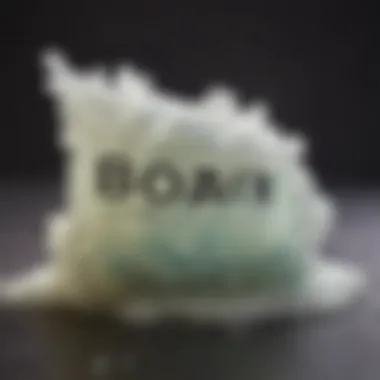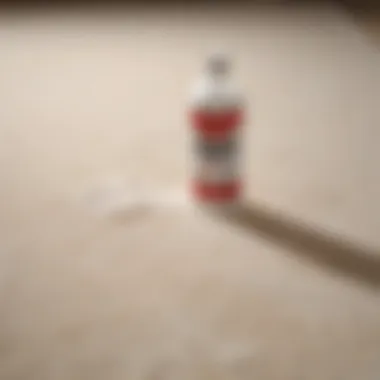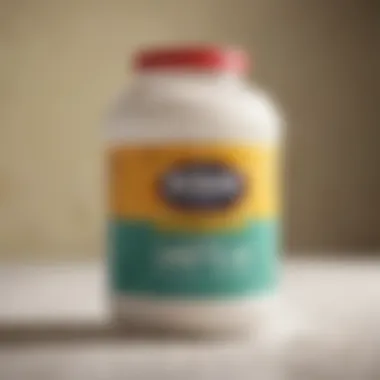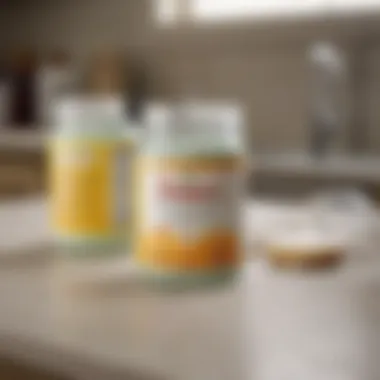Effective Use of Borax for Flea Control


Intro
Flea infestations pose a significant nuisance for many homeowners. Their resilience and rapid reproduction can make them difficult to control. In recent years, non-toxic methods for pest control have gained traction, offering safer alternatives to traditional chemical treatments. Among these methods, borax has surfaced as a favored solution. Its effectiveness and low toxicity make it a strong candidate for dealing with fleas.
This article will provide an extensive look into utilizing borax as a viable option for flea control. We will explore its chemical properties, historical use in pest management, and practical applications, ensuring a thorough guide for effective use in domestic environments. Furthermore, we will discuss safety measures and maintenance practices to optimize results.
Understanding the multifaceted nature of borax in pest management expands the toolkit available to homeowners seeking effective solutions.
Understanding Fleas and Their Impact
Understanding fleas is essential for implementing effective pest control measures. Fleas are not only a nuisance but also pose significant health risks to both humans and pets. They are parasites that feed on the blood of their hosts, potentially leading to allergic reactions and skin irritations. Furthermore, fleas can transmit various diseases and tapeworms, making it crucial to address infestations promptly.
The Biology of Fleas
Fleas, belonging to the order Siphonaptera, are small, wingless insects characterized by their flattened bodies and powerful hind legs. These adaptations allow them to leap significant distances, aiding in mobility between hosts. Adult fleas measure about 1.5 to 3.3 mm in length and exhibit a dark reddish-brown color. The biology of fleas enables them to thrive in various conditions, laying numerous eggs daily, which subsequently hatch into larvae.
Lifecycle of a Flea
The lifecycle of a flea consists of four stages: egg, larva, pupa, and adult. Female fleas lay eggs on the host, which fall off into the environment. The eggs hatch into larvae within a week. Larvae thrive in dark and moist areas, feeding primarily on organic debris, including flea feces. After several molts, the larvae spin cocoons and enter the pupal stage, where they can remain dormant for extended periods until conditions are favorable. Adult fleas emerge from the pupae, seeking a host to feed upon. This lifecycle, coupled with quick reproduction rates, explains why flea infestations can escalate rapidly.
Flea Infestations in Homes
Flea infestations commonly occur in homes, particularly where pets are present. Once introduced to the environment, fleas can spread throughout living spaces, utilizing carpets, upholstery, and pet bedding as harborage. Continuous movement in search of food contributes to their persistence. Signs of flea infestations include itching and scratching in pets, flea bites on humans, and visible flea droppings or adults in the fur of affected animals. Identifying and understanding these signs is a critical step in effective flea control.
Preface to Borax
Understanding Borax is essential for effectively implementing it as a solution for flea control. This section delves into the chemical itself, outlining its properties and historical background. Knowing what Borax is, its past applications, and its composition can inform users about its benefits as a non-toxic alternative for pest management. By understanding Borax thoroughly, readers can appreciate how it interacts with both fleas and the environment, leading to more effective application methods.
What is Borax?
Borax, chemically known as sodium borate, is a naturally occurring mineral that has various uses. It appears as a white powder and is commonly used in cleaning products, cosmetics, and, importantly, pest control. It functions as a desiccant which means it absorbs moisture. When applied to areas infested with fleas, it draws out water from the pests, leading to their dehydration and eventual death. This unique mechanism sets it apart from many conventional pesticides, making it an attractive option for individuals seeking safer alternatives.
Historical Uses of Borax
Borax has a long history that dates back to ancient times. It has been utilized in a variety of applications from textiles to food preservation. In pest control, Borax has been used historically for its effectiveness against insects. Its properties made it a preferred choice, particularly in households looking for non-toxic solutions. Before the advent of synthetic pesticides, many relied on Borax to manage pest issues. This legacy of use underscores its credibility and reliability as an effective agent in flea control.
Chemical Composition and Properties
Borax consists primarily of boron, sodium, oxygen, and water. Its chemical formula is Na2B4O7·10O, indicating that it is a hydrated borate mineral. The presence of boron gives Borax its ability to disrupt the biological processes of insects. Additionally, its low toxicity to humans and pets makes it a safer alternative when compared to harsher chemical pesticides. Furthermore, its high solubility allows it to be mixed easily with water and applied in various methods, enhancing its utility in flea control.
Important Note: Understanding Borax's properties not only allows for effective flea control but also helps in promoting an eco-friendly pest management approach.
Effectiveness of Borax in Pest Control
Understanding the effectiveness of Borax in pest control is crucial for homeowners looking for non-toxic alternatives to chemical solutions. Fleas are tenacious pests, and their resistance to standard treatments often compels individuals to seek innovative ways to tackle infestations. Borax offers a unique approach; it disrupts the natural biology of fleas while also providing additional benefits for general pest control in household environments.
How Borax Kills Fleas
Borax, or sodium borate, operates primarily through a mechanical action. When fleas contact or ingest this compound, it causes dehydration. The powder disrupts their exoskeleton, leading to moisture loss and eventual death. Fleas are tiny creatures; thus, they are particularly susceptible to such desiccation.
Furthermore, Borax affects the larval stage of fleas. Once the adult fleas lay eggs, using Borax as a treatment in areas such as carpets or under furniture can kill both existing fleas and their eggs. This dual action makes Borax highly effective in breaking the flea lifecycle.
"Effective flea management often relies on targeting various life stages to prevent a resurgence of the population."


Comparative Analysis with Other Pest Control Methods
In comparing Borax to other pest control methods, it's essential to look at both chemical and natural options. Traditional chemical treatments, like permethrin and fipronil, can be effective but may pose health risks to humans and pets. These chemicals have odors, and some individuals experience allergic reactions. Borax, on the other hand, is relatively safe when handled appropriately.
Natural alternatives include diatomaceous earth and essential oils. While both can be effective, they often require multiple applications for sustained results. Borax’s ability to kill fleas on contact and disrupt egg hatching gives it an edge in efficiency. Additionally, it simplifies the application process due to its effectiveness in dry powdered form.
In summary, Borax stands out in the wide array of pest control methods due to its practical application and safety profile. Its unique capacity to impact the flea lifecycle makes it a compelling choice for individuals seeking a more sustainable solution for pest management.
Preparing for Borax Application
Preparing for the application of Borax is a crucial step that can significantly impact the effectiveness of flea control. Proper preparation ensures that the Borax can work optimally in combating flea infestations. Neglecting this phase can lead to less effective results, which can prolong the issue and become frustrating. Understanding the infestation, gathering correct materials, and creating an environment conducive to treatment are vital aspects.
Assessing the Infestation
Before applying Borax, it is important to assess the extent of the flea infestation. Identify the areas in your home that have the highest concentration of flea activity. Look for signs such as flea dirt, which is small black specks that resemble pepper on your pets or in areas where they rest. Additionally, pay attention to any bites or irritation on your skin, as this can indicate your own exposure to fleas.
Understanding how severe the infestation is allows you to determine if Borax is sufficient as a solution or if you may need to seek alternative measures. Not all infestations require the same level of intervention; some areas may need more concentrated efforts compared to others.
Gathering Necessary Materials
Once you've assessed the infestation, gather the necessary materials for the Borax application. Essential items include:
- Borax powder
- Broom or vacuum cleaner
- Spray bottle with water (optional)
- Gloves to protect your hands
- A mask to avoid inhaling any dust from Borax
Having these materials ready in advance facilitates a smoother application process. Borax is a fine powder. It is important to handle it with care to avoid dispersing particles into the air, which can trigger respiratory issues or skin irritation if there is direct contact.
Creating a Suitable Environment
Creating a suitable environment for applying Borax is the final step in preparation. Before using Borax, ensure that the areas to be treated are clean and free of clutter. This includes removing any pet bedding or toys temporarily to allow the product to reach fleas and their eggs effectively.
Lightly dampening the area with water before application can also enhance the effectiveness. The moisture helps Borax adhere to surfaces and penetrates deeper into carpets and floors.
It is important to keep humans and pets away from treated areas for at least a few hours after application to avoid any potential exposure to Borax. It is advisable to ventilate the area by opening windows or using fans to minimize the buildup of any dust particles in the air. This ensures both safety and the maximum impact of the treatment.
Applying Borax for Flea Control
Applying Borax is a critical step in effectively managing flea infestations in homes. This section elaborates on why it is essential to utilize Borax for flea control and what benefits it brings in this context. Borax acts not just as a pesticide but also as a dehydrating agent, disrupting the fleas' lifecycle and reducing their populations over time.
When you apply Borax, you treat areas where fleas usually hide. This can include carpets, upholstery, and pet bedding. The applicability of Borax stands out for its non-toxic nature, making it a safer choice compared to many traditional flea treatments. Additionally, it can enhance your pest control routine by providing a long-lasting solution.
Considerations such as safety precautions and proper application techniques will be emphasized in this section. Understanding these will maximize the efficacy and help minimize potential risks associated with incorrect usage. Overall, applying Borax is an effective strategy designed to combat flea infestations and maintain a pest-free environment.
Step-by-Step Application Process
To ensure a successful flea control strategy using Borax, following a systematic application process is crucial. Here are the detailed steps:
- Preparation: Begin by preparing your space. Move furniture and belongings to access all affected areas.
- Spread Borax: Use a shaker or duster to apply a thin layer of Borax over the targeted surfaces.
- Target areas: Concentrate on carpets, rugs, and regions frequented by pets.
- Wait: Allow the Borax to sit undisturbed for at least 12-24 hours. This extended duration helps penetrate into fleabites and reproductive areas.
- Vacuum: After the waiting period, thoroughly vacuum all treated areas to remove the Borax along with the dead or dying fleas.
- Dispose: Empty the vacuum bag or canister outside to avoid reinfestation.
Following these steps increases the likelihood of effective flea control, making Borax a viable method in pest management.
Target Areas for Treatment
Identifying the correct areas for treatment is vital when applying Borax against fleas. Focus on spots where fleas are most likely to congregate and reproduce:
- Carpets: Fleas thrive in the fibers and can lay eggs in the carpet pile. Targeted treatment here is essential.
- Rugs and Mats: Rugs, especially those not frequently moved, can be hot-spots for fleas.
- Furniture: Apply Borax on upholstery and under cushions. Fleas can hide in these cozy areas.
- Pet Bedding: Areas where pets rest are critical. Wash and treat these spots frequently for best results.
- Cracks and Crevices: Areas that are difficult to access can also serve as hiding spots for fleas. Borax can penetrate these tight spaces.


Regular treatment of these areas can significantly reduce flea populations and prevent re-infestation.
Recommended Dosage and Dilution
The effectiveness of Borax is influenced by the dosage used during application. Here are guidelines for proper usage:
- General Application: Use approximately 1-2 cups of Borax for a standard-sized room (about 200 sq ft).
- Carpets and Rugs: For dense carpet, slightly increase the amount to ensure even coverage.
- Dilution: Generally, Borax is applied as a dry substance. Dilution is not typically necessary, but if used in solution form, a ratio of about 1 cup of Borax to 2 gallons of water can be effective for light applications.
Adhering to dosage guidelines ensures not only efficacy but also safety for both pets and humans while managing flea infestations.
Safety Precautions
In the context of utilizing Borax for flea control, understanding safety precautions is crucial. Borax, while a relatively effective pest control agent, can pose certain risks when handled improperly. By emphasizing proper safety measures, you can ensure a smooth and secure flea treatment process. It helps create a safe space for both humans and pets, avoiding unintended consequences.
Handling Borax Safely
When using Borax, it is essential to take precautions to minimize exposure. Always wear gloves when handling Borax. This helps protect your skin from potential irritation. If you get Borax on your hands, wash them immediately with soap and water.
Additionally, make sure to store Borax in a secure location, out of reach of children and pets. This reduces the risk of accidental ingestion or exposure. Proper ventilation is also important. When applying Borax in a closed space, open the windows to allow fresh air circulation. It is advisable to avoid inhaling dust, as it may cause respiratory irritation.
If you notice any adverse reactions, like skin rash or breathing difficulties, stop using Borax immediately and seek medical advice. These steps ensure that the flea control process remains efficient while keeping safety at the forefront.
Environmental Considerations
Using Borax impacts the environment as well. While it is considered less toxic than many conventional pesticides, it is still important to be mindful of its effects. Borax can harm aquatic life if it enters waterways. To minimize risk, always adhere to the recommended methods for application. Do not allow Borax to wash down drains or enter local water bodies.
Using Borax strategically in your home can also minimize environmental footprint. Favor targeted application methods rather than widespread use. This ensures that you only treat the areas affected by fleas, reducing excess use of the product.
Overall, ensuring that Borax is applied with care protects both your household and the surrounding ecosystem.
Proper handling of Borax and awareness of its environmental impact can lead to successful flea control without compromising safety.
Post-Application Maintenance
Post-application maintenance plays a crucial role in the effective control of fleas using borax. After applying borax, it is essential to monitor the effectiveness and take necessary steps to ensure a flea-free environment. This ongoing process involves several important elements that can significantly enhance the initial treatment's success.
Monitoring for Flea Activity
Monitoring for flea activity is critical to assess the effectiveness of the borax treatment. Fleas have a lifecycle that involves eggs, larvae, pupae, and adults. Consequently, it is important to regularly check for signs of fleas in the treated areas.
Some effective strategies include:
- Visual Inspections: Examine areas where pets frequent, such as carpets, rugs, and bedding. Look for live fleas, flea eggs, or flea dirt.
- Flea Traps: Consider using flea traps that can capture adult fleas. These traps often use light or heat to attract fleas.
- Checking Pets: Regularly groom pets using a flea comb to detect any fleas on their fur. Pay close attention to the neck and base of the tail, as these areas are common hiding spots.
By consistently monitoring flea activity, you can determine if further treatment is necessary or if the initial borax application has been effective.
Cleaning and Vacuuming Strategies
Cleaning and vacuuming are vital components of the post-application maintenance phase. Fleas and their eggs can remain in the environment, and effective strategies can significantly reduce their population.
Here are some recommended cleaning practices:
- Vacuuming: Vacuum thoroughly, focusing on carpets, cushions, and areas under furniture. The suction can help remove adult fleas, larvae, and eggs.
- Frequent Cleaning: After initial vacuuming, continue to vacuum daily for several weeks. This maintains pressure on the flea population, preventing re-infestation.
- Dispose of Vacuum Bags: If using a vacuum with bags, dispose of them immediately after use. For bagless vacuums, ensure to empty the canister outside to avoid reinfestation.
- Washing Fabrics: Wash pet bedding, curtains, and any other removable fabrics in hot water. This action can kill any fleas that may have been missed during vacuuming.
- Spot Treatments: In high-traffic areas, consider additional borax treatments or specific flea sprays designed for small areas, enhancing the effectiveness of the previous application.


By establishing a consistent cleaning routine, you minimize the likelihood of fleas returning and protect your living space effectively. Maintaining cleanliness after borax application enhances the overall efficacy of your flea control efforts.
Limitations of Borax for Flea Control
Using borax for flea control can be effective, but it is essential to understand its limitations. While borax has properties that can help manage flea infestations, it is not a one-size-fits-all solution. Different environments and circumstances can affect its efficacy. Recognizing when borax may fall short can help users make informed decisions about their pest control strategies.
Potential Drawbacks of Borax
Borax is generally regarded as safe for household use, yet it has several potential drawbacks. One critical issue is its effectiveness against all life stages of fleas. Borax primarily targets adult fleas and may not effectively deal with flea eggs and larvae. This limitation means that even if adult fleas disappear, the remaining eggs could hatch, continuing the infestation cycle.
Additionally, borax may lose potency depending on the surface it is applied to. For instance, porous surfaces might absorb the substance more readily, affecting its pest-killing properties. Furthermore, the product can be harmful to pets and young children if ingested or if they come into direct contact with the applied areas. Therefore, careful consideration must be given to how and where it is used.
A potential concern is its environmental impact. While borax is often seen as a more eco-friendly option compared to conventional pesticides, overuse can still lead to soil contamination or harm local plant life.
When to Seek Professional Help
In some cases, relying solely on borax for flea control may not suffice. If an infestation persists despite repeated applications of borax, it indicates a deeper issue that needs addressing. This scenario may arise from a few factors:
- Severity of Infestation: Extensive infestations are likely beyond borax's capability to manage effectively. In these cases, a professional pest control service might be necessary to assess the situation accurately and provide stronger treatments.
- Multiple Pest Issues: Often, other pests accompany flea infestations, complicating the situation. If there are signs of other pests, such as ticks or mites, a professional will implement a comprehensive plan to tackle multiple threats simultaneously.
- Health Concerns: If flea bites lead to severe allergic reactions or other health problems in pets or humans, the situation calls for immediate professional intervention. These experts can choose appropriate methods and materials that reduce health risks.
Alternative Methods for Flea Control
Flea control poses a significant challenge for many households. While borax serves as an effective solution, it is essential to recognize that it is not the only strategy available. Exploring alternative methods for flea control broadens your options and allows for tailored approaches depending on individual circumstances. Each strategy has its own advantages and considerations. Understanding these can enhance your ability to control flea populations efficiently.
Natural Pest Control Options
Natural pest control options can be appealing to those who prioritize eco-friendliness and non-toxic methods. These alternatives typically utilize naturally occurring substances or methods to deter or eliminate fleas. Common natural options include:
- Diatomaceous Earth: This powder disrupts the exoskeleton of fleas, leading to dehydration. It can be applied in areas where fleas are likely to hide.
- Essential Oils: Citrus oils, lavender oil, and peppermint oil are known to repel fleas. Diluting them in a carrier oil and applying them to pet fur can help deter fleas naturally.
- Herbal Flea Collars: Making collars infused with herbs such as rosemary or mint can provide a protective barrier for pets.
- Regular Bathing: Washing pets regularly with a mild soap can help in removing fleas before they establish an infestation.
Using natural options, however, may require more frequent applications and diligence. Moreover, effectiveness can vary based on flea life stages and environmental conditions.
Chemical Treatments and Their Impact
Chemical treatments are often regarded as strong options for flea control. These can include topical treatments, sprays, and oral medications specifically designed to eliminate fleas. Some chemical options include:
- Flea Spot-On Treatments: These products, such as Frontline or Advantage, provide fast relief by killing fleas and preventing new infestations. They are easy to apply but often require a prescription or purchase through veterinary clinics.
- Indoor Sprays and Foggers: These chemical applications treat furniture and carpets directly. They often contain insect growth regulators that break the flea lifecycle.
- Oral Medications: Prescription medications like Comfortis can provide an effective means to control fleas by targeting adult fleas quickly.
While chemical treatments can be highly effective, they are not without drawbacks. Pets may have sensitivities, so consulting a veterinarian is essential before use. Additionally, many chemical treatments can harm beneficial insects, highlighting the need for careful consideration when applying them indoors or outdoors.
Carefully evaluate your environment and pet health before choosing a flea control method. Each approach has its pros and cons, tailoring your choice to specific needs ensures effectiveness and safety.
In summary, exploring alternative methods for flea control provides flexibility in handling infestations. Emphasizing natural options can support an eco-friendly home, whereas chemical solutions can deliver rapid results when necessary. Understanding the nuances of each method lets homeowners decide the best course for effective flea management.
Finale
The conclusion of this guide significantly ties together the various aspects of utilizing borax for flea control. Readers must see the article's inherent value in providing not just a method for tackling a persistent household problem, but also insights into the properties of borax itself. An understanding of how borax functions as an effective solution reflects its role as a non-toxic option compared to harsher chemicals.
Summary of Key Points
To recap, this article has covered essential topics:
- Borax is a natural mineral known for its insecticidal properties.
- Fleas can cause discomfort and health risks for both pets and humans, making timely management critical.
- The application process for borax involves assessing the area, preparing materials, and ensuring consistent monitoring post-application.
- Safety is crucial; proper handling of borax prevents potential harm to pets and occupants.
- While borax is effective, understanding its limitations is key. There are circumstances when professional intervention might be necessary.
In this outline, we have established a clear understanding, focusing on the practicalities of implementing borax in household flea management. This not only empowers homeowners with knowledge but also highlights a method that respects both pets and the environment.
Final Thoughts on Flea Management
Flea management is more than simply applying a solution. It requires comprehensive action and preparation. Utilizing borax is a step towards a holistic approach that respects natural environments while effectively addressing flea infestations.
The essence of this article rests in the empowered homeowner's journey. Understanding the lifecycle of fleas and the properties of borax allows for informed decisions. This method should encourage readers to explore additional natural alternatives and best practices.







